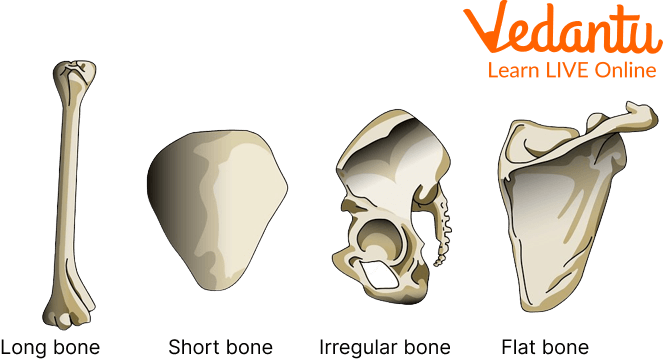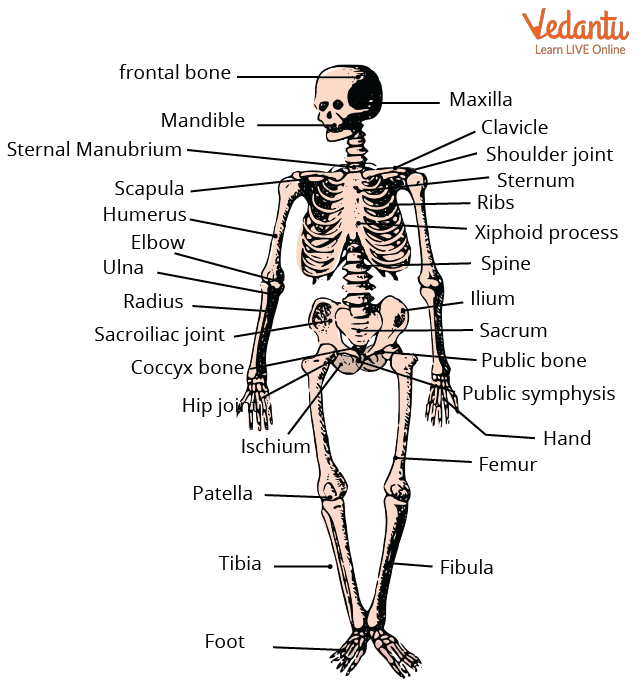




Major Bone Types and Their Functions Explained
Hey, do you remember the “Grim Reaper” from the show “Grim Adventure of Billy and Mandy”? He was essentially not a human, rather a talking skeleton. The skeleton is the inner hard structure of our body and is made of a number of bones. Bones are solid structures made up of proteins and minerals and provide a shape to the body. They act as a protective layer for all the internal organs such as the brain, heart, lungs, etc and they are known to give support to the organs within the body and also anchor muscles.
Types of Bones in the Human Body
There are a variety of bones found in our body and can be of multiple sizes and shapes.
There are 4 major types of bones in our body, i.e. long, short, flat, and irregular.
Long Bones
These bones have a much greater length than width and hence are called long bones.
They can be described as a long shaft almost like a rod with two bulky ends looking like a dumbbell.
They are mostly very solid but might have a large number of spongy portions in them at both ends.
The bones of the thigh, leg, arm, and forearm are all long bones.
Short Bones
These bones are cube-shaped with almost equal length and breadth.
These bones are primarily spongy and covered with a thin layer of compact bone.
The bones present in the wrist and ankle are the short bones.
Flat Bones
These bones do not have much volume and are essentially flat and thin and also curved.
Cranium is made up of flat bones.
Irregular Bones
These are the bones that do not have a specific shape in order to classify them into any of the above groups.
These are the spongy bones that are covered by a thin layer of compact bone.
Bones of the vertebrae and some skull bones are all irregular bones.

Types of Bones
List of Human Bones
Humans have a total of 206 bones in their bodies.
There are many groups of bones in the human body.
Many parts of our skeleton are made up of multiple small bones joined together to form a proper structure.
The various groups include,

Bones
Bones in the Head:
Cranial Bones (8):
Frontal, parietal (2), Temporal (2), Occipital, Sphenoid, Ethmoid
Facial Bones (14):
Mandible, Maxilla (2), Palatine (2), Zygomatic (2), Nasal (2), Lacrimal (2), Vomer, Inferior Nasal conchae (2)
Ear Bones (6):
Malleus (2), Incus (2), Stapes (2)
Throat Bones (1):
Hyoid
Shoulder Bones(4):
Shoulder blade (2), Collarbone (2) (also called the clavicle)
Thorax Bones (25):
Sternum (1), Ribs (2 x 12)
Vertebral Column Bones (24):
Cervical vertebrae (7), Thoracic vertebrae (12), Lumbar vertebrae (5)
Upper Arm Bones (2):
Humerus (2)
Forearm Bones (4):
Radius (2), Ulna (2)
Wrist Bones(16):
Scaphoid (2), Lunate (2), Triquetral (2), Pisiform (2), Trapezium (2), Trapezoid (2), Capitate bone (2), Hamate (2)
Palm Bones:
Metacarpals (5 x 2)
Finger Bones:
Proximal phalanges (5 x 2), Intermediate phalanges (4 x 2), Distal phalanges (5 x 2)
Pelvis Bones (4):
Sacrum, Coccyx, Hip bone (2)
Leg Bones (8):
The femur or thigh bone (2), Patella (2), Tibia (2), Fibula (2)
Ankle Bones(24):
Calcaneus (heel bone) (2), Talus (2), Navicular (2), Medial cuneiform (2), Intermediate Cuneiform (2), Lateral cuneiform (2), Cuboid (2), Metatarsal bone (5 x 2)
Toe Bones:
Proximal phalanges (5 x 2), Intermediate phalanges (4 x 2), Distal phalanges (5 x 2)
Function of Bones
They provide structural support to the body.
The bones joined at different locations allow various movements.
They are known to protect various vital organs such as the rib cage protects the heart and lungs.
The blood in our body is formed within the bones by the bone marrow or specifically the red marrow.
The bones are also important for storage of minerals such as calcium and phosphorus.
Summary
Bones are the framework of the body which is important to stand erect and help to protect different delicate organs. The largest and strongest bone is the femur or thigh bone. The bones won’t grow after puberty, the density and strength change over time.
FAQs on Types of Bones in Human Body
1. What are the major groups of bones in the human body?
The adult human skeleton has 206 bones, which are organised into two main parts: the axial skeleton (the body's central core) and the appendicular skeleton (the limbs). These include major groups like:
- The Skull (protects the brain)
- The Vertebral Column (spine)
- The Rib Cage (protects the heart and lungs)
- Bones of the Arms and Hands
- Bones of the Legs and Feet
2. What are the main functions of bones in our body?
Bones have several vital functions beyond just providing shape. The main ones are:
- Support: They provide a framework for the body.
- Protection: Bones like the skull and rib cage protect delicate internal organs.
- Movement: Muscles attach to bones to allow movement.
- Blood Cell Production: Red and white blood cells are produced in the bone marrow.
- Storage: Bones store important minerals, especially calcium and phosphorus.
3. What is the longest and strongest bone in the human body?
The longest and strongest bone in the human body is the femur, which is the thigh bone. It runs from the hip to the knee and is crucial for standing and walking, as it has to support the entire weight of the body.
4. What are the smallest bones in the body?
The smallest bones in the human body are the three auditory ossicles located in the middle ear. They are named the malleus (hammer), incus (anvil), and stapes (stirrup). Together, they help transmit sound vibrations to the inner ear.
5. How are bones classified based on their shape?
Bones are often classified into four main types based on their shape, which relates to their function:
- Long Bones: Longer than they are wide (e.g., femur, humerus).
- Short Bones: Roughly cube-shaped (e.g., carpals in the wrist).
- Flat Bones: Thin, flat, and often curved (e.g., ribs, skull bones).
- Irregular Bones: Have complex shapes that don't fit into other categories (e.g., vertebrae, hip bones).
6. Why do babies have more bones than adults?
Babies are born with about 300 bones, which is many more than the 206 in an adult. This is because many of their bones are actually soft cartilage that gradually fuses together as they grow. This flexibility helps during birth and allows for rapid growth during infancy.
7. Are bones actually living tissue?
Yes, absolutely. Bones are a type of living, growing connective tissue. They have their own network of blood vessels to supply nutrients and nerves. Bones are constantly breaking down old tissue and rebuilding new tissue in a process called remodeling, which keeps them strong.
8. What holds our bones together at the joints?
Bones are connected to each other at joints by strong, fibrous bands called ligaments. This allows for movement while providing stability. Joints are also cushioned by cartilage to prevent bones from rubbing against each other.









